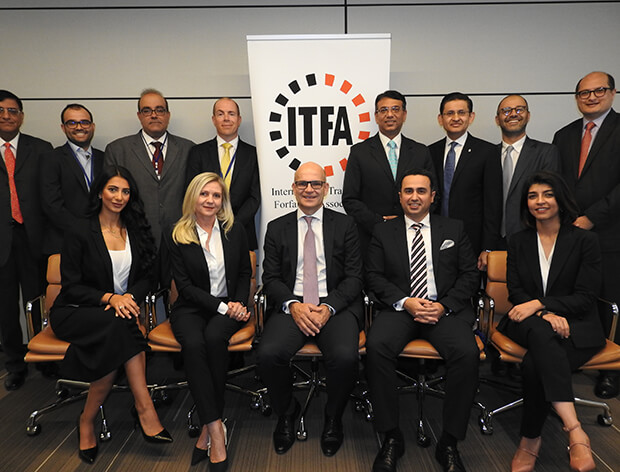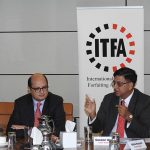GTR and ITFA’s Middle East Regional Committee gathered key players from across Mena’s trade ecosystem to talk about how well the region is faring in a world of trade wars and rapid digital transformation.
Participants:
Halina Bernard, head of treasury, General Motors Africa and Middle East
Maninder Bhandari, director, Derby Group (chair)
Rahul Daswani, senior manager, treasury capital management, Microsoft
Motasim Iqbal, UAE head of transaction banking, Standard Chartered Bank
David Leslie, UAE head of trade and receivables finance, HSBC
Bruno Massera, treasurer, Mena and Turkey, BRF
Sinan Ozcan, senior executive officer, Maersk Trade Finance
Daniel Schmand, global head of trade finance, Deutsche Bank and chairman of the ICC Banking Commission
Kamran Zaidi, head of trade finance and global subsidiary coverage, GCC and Pakistan, Deutsche Bank
Bhandari: From a macro trade perspective, what are you seeing happening right now and what do you expect going forward?
Schmand: Where everybody has to do their own work is to have a fair assessment of the geopolitical uncertainty. You need to run a few scenarios: what will happen if the Trump administration further tightens trade policy; what will be the counter-reaction from China; what roles do Europe and Mena play there; and is Africa going to be an interesting spot because it is not affected as of yet?
The big question for trade finance is, what is next and what is new? From the product perspective, we will see twists and tweaks, but the product is already there. There is nothing fundamentally missing in terms of financing techniques and abilities; it is more the question of going digital. The industry recently launched the Trade Information Network at Sibos. It’s quite interesting, because everybody assumes it’s blockchain, but it’s not. When I am asked how to best describe it, the Trade Information Network is a kind of a Swift network for open account. It will be inclusive, with no majority shareholder and no economic interest of the founding banks. It is just an enabler to allow global trade finance to be more inclusive.
Iqbal: I see two sets of actions being taken globally: protectionism at one end, and liberalisation at the other. We are seeing a shift in global flows from enhanced protectionism between the US and China. It’s quite interesting what is happening. I worked in Singapore for a long time, and we used to see our customers importing soybeans from the US to China. As many of you would know, 60% of the global procurement of soybeans is done by China. In 2017, US$12bn of soybeans was bought by China from the US. Guess what has happened in 2018? On the back of all the additional tariffs that have been put up, China has now started buying soybeans from Brazil. This is an interesting shift in terms of the global flows that we are seeing.
China has been embarking on the Belt and Road Initiative. It has realised that it needs to shift its dependence on one massive corridor, so it is trying to go into other countries, whether it is in Africa, in Asia or in the subcontinent.
Meanwhile, Europe is embarking on a wave of liberalisation by entering into bilateral free trade agreements (FTAs) with a lot of countries. We have seen the EU enter into an FTA with Singapore and South Korea, and overall trade will benefit from that.
Ozcan: The scale and complexity of global trade, the separate flow of goods and money is still causing a lot of complexities. There are multiple stakeholders, information asymmetry, high-risk, limited transparency, and these are all ending up in manual processes and wasted resources. In fact, the OECD says that 15% of the value of traded goods globally is in costs, and much of it is because of the manual processes. We are not doing business as we were 10 years ago, and we will not be doing business 10 years from now as today.
You have seen many key players in the market who could not predict the change and who are just resisting it. Banks and carriers thought that scale is the key, and when the markets fluctuated they only found themselves overexposed.
Zaidi: From a trade war perspective, the region per se has not seen any impact at the moment. This does not mean that there will not be an impact. Potentially for certain commodities we may see a very positive impact, particularly when it comes to petrochemical flows or some of the value-added re-export commodities that you see out of here.
When we look at petrochemicals, and this is the largest commodity after crude oil and is part of every manufactured product here, China has been buying from the US thanks to all the shale gas production that has emerged over the last three to four years. There is sizeable production that is slated to come on over the next three or four years in the US. The US has to export it, so it has to find new markets. China’s dependence would then potentially increase on the Middle East countries, the GCC, who are already very big exporters to China, but their share of the volume would most likely increase. So, we are going to see changes. We will see opportunities. At the same time, other commodities may face a negative impact thanks to the trade war.
Iqbal: You made an interesting point: goods will find markets. That is very critical, because if you look at how the prices of soybeans have reacted, as China stopped buying US soybeans, the prices for US soybeans have come down, but Brazilian soybeans went up at a premium because China had to go for alternatives. Guess who started buying the US soybeans? Other markets like Pakistan and India, who also have a big demand, have latched onto the opportunity of cheaper soybeans from the US and have started picking that up.
That is where financing institutions and all of us collectively have to track how these corridors are going to change. We need to be very agile. It is quite likely that this part of the world will also start benefiting from the trickle-down effects of changing or reshaping trade corridors.
Massera: The world is changing. There is a lot of protectionism. Governments want to stimulate local production. This will bring opportunities for trade finance locally.
Daswani: Think about the fact that trade is not just goods. Approximately 50% of the world GDP is services and value add as per the World Bank, and this is also a part of world trade that will need financial institutions’ support. Additionally, with the growth in digital transformation, whether it is e-retailers or purely purchases of software, apps, games, e-news, there is a lot of activity around digital trade that financial institutions need to be considering for the development of solutions.
It is a very exciting time to be in the software business, because this is where we are seeing a growth opportunity. There are estimations that digital transformation opportunities for companies create a market opportunity of US$5tn. Microsoft, Amazon, Google and Facebook are all seeing steady revenue growth from this opportunity. That poses a very interesting question for this part of the world, because we are starting to see a point where the growth rates in the technology business are much higher in the Western market than in the Middle East and Africa. So even if we have good growth rates here, companies are prioritising resources to US and Western Europe where the growth rates are higher.
In this part of the world, the Middle East and Africa, I personally feel that the investment dollars are needed to boost the digital transformation journey. The budgets of various companies and governments are still at an early stage of considering the spend needed for digital transformation and prioritising it together with other budgets like agriculture, health and infrastructure budgets.
Bhandari: What needs to happen to boost digital transformation in the region? Is the dollar available? Or does something need to change to make it further available?
Zaidi: The fundamental thing is that the regulatory framework in this region has a way to go. The dollars spent in this region are a lot fewer compared to what the Western world is spending and developing. The corporates are also slow in adopting, because there is a lot of bureaucracy going on within the large companies.
Schmand: The money is there. The question is, why do people not invest? Why does the liquidity not hit the areas where it is needed the most? In financing any emerging market, the answer is very simple: the markets are not ready to absorb it and to provide the infrastructure and framework to get invested in.
Ozcan: I think it is also because we are not developing the right tools and methods. SMEs are still put in a collateral trap with the existing methods. You keep asking for mortgages, pledge on fixed assets, cash margins as security, etc. Similarly, the bill of lading is a hundreds-of-years-old document and is still used as the main document to transfer the title of the goods.
This is one of the reasons why we launched Maersk Trade Finance, removing the paper-intensive processes and taking the cargo we carry as security. It’s not the technology alone which will fix all the problems we have today, it’s the innovation. For that to happen, re-thinking the traditional methods is the way ahead.
Schmand: For this region, how is an electronic signature handled legally? Is an electronic signature in this country fully legally valid? In our experience, the only country where it is fully available and legally possible is the US. Not even in developed markets. So it’s not about blockchain, outer space, and whatever you have. If blockchain would be the ‘Holy Grail’ and the source of solving problems, why is it not taking off? It’s not a technology question. The critical question is: is the environment and the system able to deploy the technology to its possibilities? It is not good enough.
In Singapore, we have seen the launch of the Singapore National Trade Platform, for example. Within this context, you need to find a multi-country or a supranational solution as well as processes and procedures.
Bhandari: Let me for argument’s sake be the devil’s advocate. As a businessperson, I would say, I don’t care. I just need funds, whether it is flown down to me or sent to me.
Daswani: We are mixing two things here: electronic processing of transactions and the availability of credit. You need to separate them. The electronic processing of transactions is very important in the Western market to achieve a low cost of delivery and make it available on a large scale. Then the low cost of funds can benefit everybody.
I don’t think that is exactly how the needs play out in this part of the world. This region needs the money itself, the credit. And every time we have this conversation, the banks get into this discussion of, how do we optimally deliver it? Well, the reality of the business environment is clear: even if you deliver it sub-optimally, ie at a higher price, the demand of credit is so high that there will be utilisation anyway.
Leslie: I agree that on average the SMEs aren’t asking for digital as much as the larger corporates, but the banks need digital to deliver what the SMEs need. A good example of that is in Mexico. In 2014, one bank suffered a very large fraud that impacted the market quite heavily. Because of that, the industry had to rethink its receivables finance controls and help banks manage those risks better. Today, as a result, Mexico has some of the most progressive solutions in the world including the RUG (Registro Unico de Garantias Mobiliarias), which is the country’s central registry for filing security interests electronically, along with the government’s web-based SAT for uniform e-invoicing for tax. In turn, banks such as HSBC integrated with such solutions, which allowed us to automate and improve our internal controls. This gave banks appetite to finance more SMEs in a cost-effective manner.
Iqbal: The way forward, and I have seen this evolve significantly over the last 12 months, is the ecosystem. It’s not just collaboration between the banks; it is also all the large corporates coming into play. It is about us looking at the ecosystem and saying, we are comfortable with you, I have to work with you to help the entire ecosystem around you, your suppliers and your distributors. I understand that the distributor part is a bit more difficult. The supplier part is an easy one to sort out. We have an automated solution, because you need that if you want to develop scale. Without digitisation, I cannot onboard 400 suppliers. That is why the digital piece is important, and we need your participation as corporates to come in and participate in the risk as well, because that puts skin in the game for everyone.
Massera: Collaboration is key. Let’s really collaborate and try to find solutions for the region. The way I see it, the technology is there, so it’s really about the regulators, the corporates and the banks working together to implement the technology. Regulation is essential. Why have the corporates in Brazil been able to develop supply chain finance programmes? Because the regulation is there, and so are the banks and the credit. So I don’t think it’s a problem of technology; it is about how we implement the technology.
Bernard: We just talked about sharing the risks. A large entity, typically for policy or risk aversion, is not always very keen to share the risk. When we look at the evaluation, we always go back to the traditional letters of credit or the traditional bills of exchange discounting. That could be one of the impediments in the entire ecosystem.
Massera: The challenge that I see specifically here in the region is on the receivables side. On the supplier side, supply chain finance is there, you have the global banks, you have the local banks catching up. But on the other side, how the corporates are able to sell their receivables to finance this side of the value chain, this is the challenge that I have been seeing in the region.
Zaidi: If you look at the fundamentals, the technology can come in and help manage the ecosystem, but the problems will persist if the transparency on the SME sector doesn’t grow. That is where the regulation needs to come into play. The one thing that will help out here is the new taxation. Typically the code of conduct of business here is to put up the collateral if you want any finance, and that is the prime challenge that we see. If there is no financial information available to banks, what should be financed? So hopefully, with taxation, in the long run you would see more visibility.
The trade finance ecosystem includes many stakeholders, including banks and, increasingly, alternative trade finance providers and fintech companies. Even ports in the region have been looking at what they can do in terms of automated solutions to make credit more fluidly available, particularly to the SMEs. Technology is not a challenge. Blockchain is there. The reason no one is on it is that everyone has their own solution. It goes back to collaboration: nobody wants to collaborate. It all goes down to who has the IP and who has the platform.
Schmand: I am a big believer in blockchain and technology. The biggest driver to make it a success is standardisation. Whether we like the Maersk format or not is irrelevant. If we have a standard, then different blockchain initiatives can talk to each other.
What we have forgotten while we were so carried away by the technology hype is, where is the standard? What do you want to put on the system or onto the cloud? We need to literally take a step back and say, let’s work on the boring stuff.
Bernard: Cross-border scalability is something that remains a challenge, so standardisation and the regulatory requirements have to go beyond just one country. It needs to be aligned to actually fit with the product or what the stakeholders would like to do with the ecosystem.
Bhandari: Big data is now gathering momentum. How could that benefit the entire trade community?
Leslie: We are seeing a real evolution in the industry from both a client and banking perspective. One of the key areas that banks needed to do better in the last 10 years was in financial crime. Historically, banks’ controls in that space have been very manual and very document driven. Today, banks, especially international banks, have a lot of data within their network. Working closely with regulators, we have implemented new technologies which leverage artificial intelligence and machine learning to make better use of that data and to identify when something doesn’t look right.
If you are banking transactions to different countries, you not only have transactional data that is going back and forth, but also the data that makes up the wider client networks. By piecing the networks together, the banks can look at what are good networks to which they can lend more, and what networks do they perhaps need to keep a closer eye on. That helps banks to have appetite to support more trade globally.
Daswani: Over the last 10 to 12 years, corporates have been employing more specialised resources that are similar to what you would get in trade and treasury teams of a bank. This has not been the case in the past. Availability of both people and system resource are now making corporates think that if they can’t get capabilities from the bank, then can they do something on their own. With the growth of fintech and AI there are possibilities that corporates may find it easier to make their own financing solutions available to their customers, as they have both better tools and insights and also more incentives to make those solutions available. It will be quite interesting to see how banks adapt and evolve to work with these new environments.
















